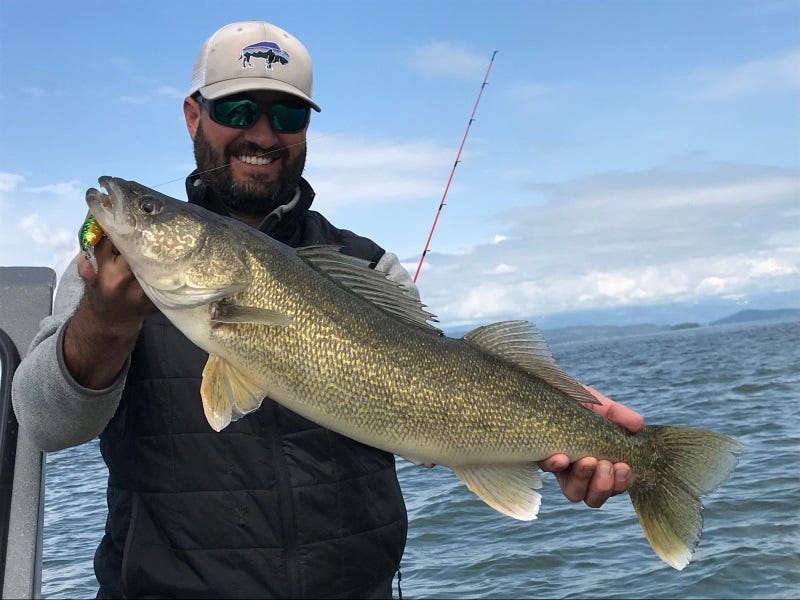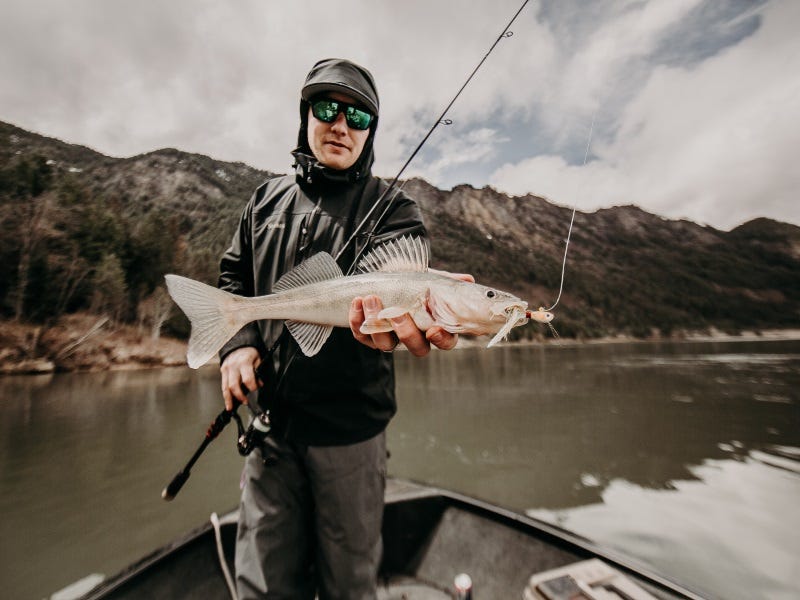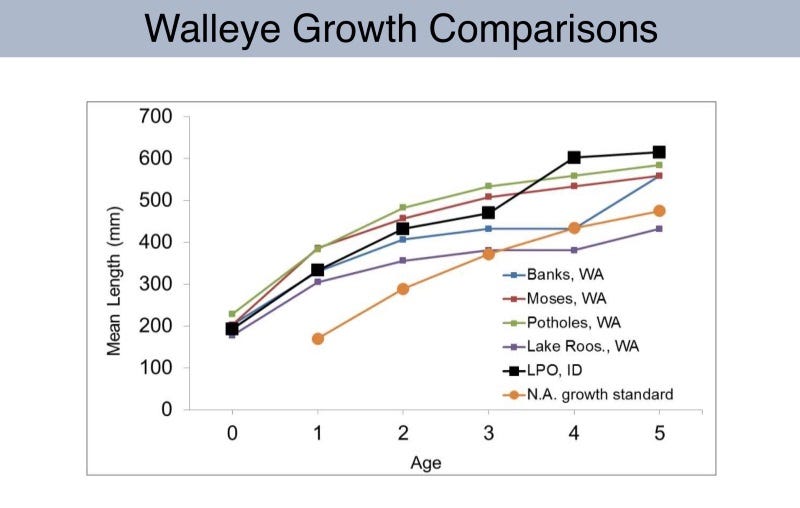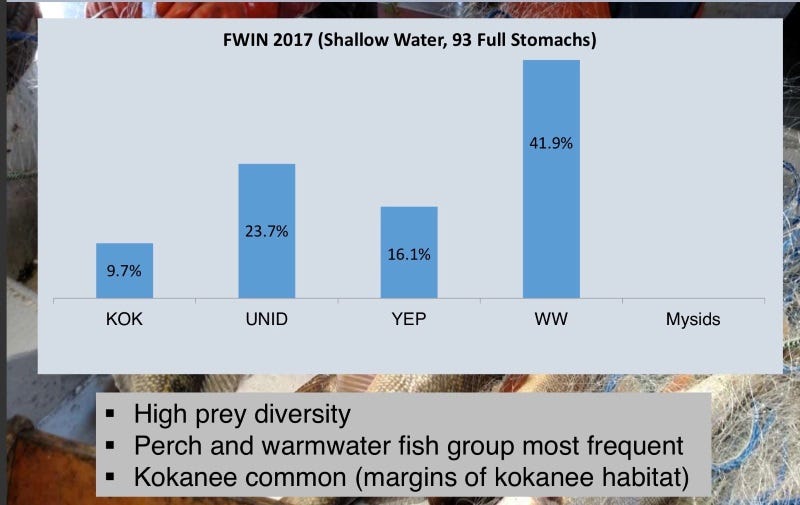The Hottest Walleye Fishery in the West - Idaho’s Lake Pend Oreille

 Emerging walleye fisheries, such as Idaho’s Lake Pend Orielle, often kick out big fish in good numbers. That’s the case right now where anglers like Calvin Fuller (shown here) are nailing walleye up to 16 pounds. This nice fish was taken a week ago on a Flickershad.
Emerging walleye fisheries, such as Idaho’s Lake Pend Orielle, often kick out big fish in good numbers. That’s the case right now where anglers like Calvin Fuller (shown here) are nailing walleye up to 16 pounds. This nice fish was taken a week ago on a Flickershad.If you’re looking for some of the biggest and baddest walleye in the Pacific Northwest, you should hitch the boat to the back of a rig and head for north Idaho’s Lake Pend Oreille.
Lake Pend Oreille is the West’s new walleye hotspot and people in the walleye circles are racing to get there. That’s because the fish aren’t picky and they grow fast due to an abundant food base—meaning scads of warm-water fishes and kokanee salmon. Visualize the early years at Canyon Ferry, Fort Peck, Boysen, and Seminole reservoirs and you can understand what type of fishing Lake Pend Oreille offers right now. Spend a day on the water and you’ll likely catch a bunch of male walleye in the two-to three-pound range; if you’re either lucky or good you’ll likely hook into a couple big females, too, meaning fish that range between four and eight pounds on average. However, be sure, there are plenty of eight-to 12-pound fish swimming here and reports of 20-pounders are circulating.
If you want in on the action, however, don’t delay—Idaho Department of Fish and Game is starting walleye suppression efforts and that means the best fishing we may ever see on this big lake is taking place right now. I hit the water last week, found the fish concentrated in specific areas, and walked away with wide eyes and some tanker-sized walleye in my cooler. This type of action should continue for a couple more weeks before the fish—especially the big females—move into a post spawn/summer pattern.
Want to win the walleye lottery? Read how here.
 During spring on Idaho’s Lake Pend Oreille you’ll catch scads of small male walleye (shown here) along with some big females. The males average a couple pounds; the females range between 6 and 16 pounds with rumors of 20-pound fish hitting the deck.
During spring on Idaho’s Lake Pend Oreille you’ll catch scads of small male walleye (shown here) along with some big females. The males average a couple pounds; the females range between 6 and 16 pounds with rumors of 20-pound fish hitting the deck.How did Walleye get into Lake Pend Oreille?
Walleye, of course, aren’t supposed to be in Lake Pend Oreille. But rumors started circulating in 2008 with people saying they caught these fish near the Long Bridge, which is located where the lake turns into the Pend Oreille River near Sandpoint.
Now, 10 years later, it’s common knowledge that LPO’s walleye are a viable fishery and they are likely here to stay. In fact, angler catch rates are increasing around the lake and walleye are showing up in almost every lake trout net trap that IDFG has put out. Even with suppression efforts, these fish are here to stay.
So, how did walleye get to Lake Pend Oreille? According to IDFG, walleye were illegally introduced in Noxon Reservoir in 1991. Since then they have trickled through Noxon Rapids Dam and Cabinet Gorge Dam, especially during high water years. In 2005 IDFG collected their first walleye during a warm-water fish survey near the Long Bridge in the Pend Oreille River. One year later walleye were collected on LPO near the mouth of the Pack River during a lake trout suppression effort. IDFG speculates that walleye were in LPO earlier than 2006. Starting in 2011 the average “walleye per net” during lake trout suppression efforts was 1.4. That number jumped to 4.3 in 2017.
 Walleye growth rates at Pend Oreille compare nicely with other Pacific Northwest walleye waters. This is typical of emerging fisheries when the food base is abundant and these fish grow fast. Image courtesy of IDF&G
Walleye growth rates at Pend Oreille compare nicely with other Pacific Northwest walleye waters. This is typical of emerging fisheries when the food base is abundant and these fish grow fast. Image courtesy of IDF&GIDFG has sampled four key areas in LPO and the Pend Oreille River. In all areas, the density of walleye has increased. We should continue to see increases in walleye in both the lake and the river until IDFG ramps up its suppression effort on these fish. Until then, anglers can expect to have success on walleye using a variety of techniques.
What's new for catching walleye? Check out our ICAST review.
Walleye are mostly river spawning fish and push up onto gravel bars during the right time periods to spawn. This annual walleye migration tends to start in LPO around the beginning or March and peak by the mid-to the end of April. Walleye are sensitive to water conditions and temperatures during the spawn. Timing can be a factor when targeting these walleye on LPO.
Large boats loaded with electronics are not needed to catch these fish. Simply hitting the right areas during the right time of year yields success. Talking with local marinas and sporting goods stores will help you key in on areas where walleye live and can be found on a consistent basis.
 Pend Oreille’s walleye fishery isn’t a secret, but it’s still in its infancy. With IDF&G employing suppression efforts, the next few years may provide the best walleye fishing this lake will ever see. Get in while the getting—especially for large fish—is good.
Pend Oreille’s walleye fishery isn’t a secret, but it’s still in its infancy. With IDF&G employing suppression efforts, the next few years may provide the best walleye fishing this lake will ever see. Get in while the getting—especially for large fish—is good.Where to Fish Walleye on Idaho’s Lake Pend Oreille
During March and April, most anglers target walleye in the Clark Fork River and its delta, meaning where the Clark Fork flows into LPO. This is a popular time to troll flicker shads, stick baits, and other deep diving crankbaits. Large walleye often hold in water that ranges between three and 20 feet at this time. The most popular areas are anywhere from 10 to 12 feet deep. Another tactic that works well is jigging in staging zones throughout the river, meaning the soft side of current lines and pools—anywhere a walleye can escape the main current and still find feed. Quarter-ounce and half-ounce tipped with Berkley gulp and nightcrawlers is a great way to catch these staging fish, which include the smaller male and some big females
As spring turns into summer, the walleye spread out throughout LPO and the Pend Oreille River. During June and into early July, the Long Bridge starts to fish very well. This usually happens right as the current begins to slow down and LPO reaches full pool. When the Long Bridge is fishing, a variety of methods work, but jigging next to the bridge usually proves most successful. Once again, I go to jig-heads tipped with Berkley Gulp and/or nightcrawlers. Another area that fishes well throughout summer is the Clark Fork River. As the lake backs up into the river and the water offers more visibility, the fish spread out and trolling for them is effective. This allows you to cover lots of water. Trolling worm harnesses and crankbaits works well and most of the walleye are in eight-to 15 feet of water.
Innovative walleye baits from Acme and Kalin's? You'll want to check these out.
In LPO, walleye can be found throughout the summer in eight-to 70 feet of water. The fish hang out in bays and near points, from the mouth of the Clark Fork all the way to the town of Sandpoint. Trolling crankbaits in Elisport Bay and along Sunnyside can produce good numbers of mature male walleye. Most people pick up these walleye as they fish rainbow trout and bass, but walleye do concentrate in certain areas, so once you find them you’re in.
Future of this Great Idaho Walleye Fishery
The future of the fishery is pretty well planned out for the next few years and right now is the time to target these fish before suppression efforts start. IDFG does not manage fish that are illegally introduced into a system, and for the time being, they do not like walleye in LPO. Walleye have proven to be extremely impactful on kokanee populations in other systems. This is a red flag for IDFG since kokanee is the main food source for LPO’s native bull trout and trophy rainbow trout. Currently, LPO is managed as a trophy rainbow trout fishery and many anglers are concerned that the coveted rainbow’s food source will be severely impacted by walleye. Other anglers think that these fish can co-exist and walleye won’t specifically target kokanee.
A panel of walleye experts and biologists have been put together to study the fishery and determine its future. Unanimously, the panel determined that walleye pose a major risk to the sustainability of LPO’s rainbow and bull trout fisheries. A study will be conducted over the next three weeks to track and monitor walleye in LPO and the Pend Oreille River. The results of this study will be made public and a plan will be put together for the future of the LPO fishery. Count on IDFG asking anglers to assist in the harvest/suppression efforts.
 Wondering what you should cast at walleye? Judging by this graph, courtesy of IDF&G, Lake Pend Oreille’s walleye crush small warm-water fishes, such as perch, along with larger kokanee salmon. Match those and you’re good to go.
Wondering what you should cast at walleye? Judging by this graph, courtesy of IDF&G, Lake Pend Oreille’s walleye crush small warm-water fishes, such as perch, along with larger kokanee salmon. Match those and you’re good to go.Best Gear for Fishing Lake Pend Oreille Walleye
When Trolling Crankbaits/Stickbaits
* Rod: 7-9’ medium action.
* Reel: Open face and/or line counter
* Line: 8-12 pound braid or monofilament. Braid with show the action of the plugs better, but has no stretch like monofilament. So, if braid is used, use a softer action rod. Braid will also cut deeper into the water column.
* Lures: Rapala jointed Shad Raps (JRS-5 & JRS-7). Rapala Tail Dancers size 7, Storm Smash Shad size 7, Berkley Flicker Shad Size 7. I like using brighter colors with off colored water like Fire Tiger and chartreuse. For clearer water, more natural colors like perch or black/silver.
Need crankbaits that won't fail? Order online here.
When Jigging
* Rod: 6’3” fast action spinning rod.
* Reel: 2500 series Shimano or Pflueger President.
* Line: 10 pound supple braid. Fluorocarbon leader 8-12 pound.
- Lures: ¼ - ½ oz. Northland Thumper Jig tipped with 2”-3” Berkley Gulp Minnow and a night crawler.
- Kits Tackle Glass Minnow Jig
Access to Lake Pend Oreille and the Clark Fork River
To access the Clark Fork River during spring, as the water rises, hit the Johnson Creek boat ramp, which is located outside the town of Clark Fork and is maintained by IDFG. Camping is allowed at Johnson Creek and there is a bathroom there as well. The water can be low in the spring when heading out to the lake and river, so watch changing river conditions and take your time figuring out this access point.
For larger boats, the Hope Boat Basin, located in the town of Hope, Idaho, is an easy way to access the entire lake and river on calmer days. It is about a 10-mile boat ride from the Boat Basin to the mouth of the Clark Fork River, so you have to watch the weather or you’ll be in for a long, bumpy and possibly dangerous ride.
To access the Pend Oreille River/Long Bridge area, the boat launch at City Beach in the town of Sandpoint is the best. This puts you within one mile of the bridge and the water/waves are not as big here as they are in other areas of the lake.
